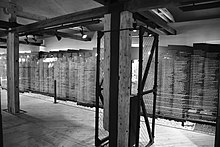Jewish Code

The Jewish Code ( Slovak Židovský kódex ) was a government ordinance issued on September 9, 1941 by the Tuka government in the Slovak state . It was a Slovak equivalent of the Nuremberg Laws .
This ordinance and the cooperation of the Slovak government with the Nazi regime led to the murder of 70,000 people.
history
In the "Jewish Code", the transition from the religious to the "racial" assessment of the Jewish question in Slovakia was completed. On the website of the Ústav pamäti národa Institute , the law is described as “one of the most brutal anti-Jewish laws in Europe”. The resolution was also based on the racial principle and defined as Jewish every Slovak citizen who was descended from at least three grandparents of the Jewish faith who had not received Christian baptism before April 20, 1939. People separated in this way had to wear a yellow Star of David and lost their rights. For example, the resolution forbade entering into a marriage between Jews or “mixed race” and non-Jews.
People who violated this decision could face three to five years in prison and lose the right to vote. Jewish citizens lost their active and passive right to vote, were not allowed to visit theaters, bathing establishments, parks and other public facilities, could not be employed as civil servants, work as doctors, work as free artists and do no editorial work.
However, President Jozef Tiso was able to issue an exemption from the provisions of the “Jewish Code” . This exception was deliberately left open in order to spare people who were particularly deserving or urgently needed in the domestic economy. According to the historian and Eastern Europe expert Jörg K. Hoensch , a third of the Slovak Jews were exempted from deportation and mass extermination due to the generous distribution of the certificates of exemption (including letters of protection) . The historian Tatjana Tönsmeyer names the number of 35,000 Jews who were in possession of such a letter of protection in 1942, repeatedly used by historians in exile Slovakia such as Milan Stanislav Ďurica , but questions this number critically. This number mostly comes from a telegram sent on June 26, 1942 by the third German envoy in Bratislava, Hanns Elard Ludin , to the German Foreign Office, in which he reports that the deportations of Slovak Jews to Auschwitz have come to a standstill. The document reads verbatim:
“The execution of the evacuation of the Jews from Slovakia has reached a dead point at the moment. Due to ecclesiastical influences and the corruption of individual officials, around 35,000 Jews have received special legitimacy, on the basis of which they do not need to be evacuated. "
A precise indication of the issued certificates of exemption and letters of protection is problematic insofar as the archive in question was examined and looted several times by the Czechoslovak authorities after the end of the war, with many important documents being lost. The defense of President Tiso before the People's Court in 1947, Ernest Žabkay, notes in his memoirs that the communist court chairman Igor Daxner refused to investigate the number of letters of protection actually issued by Tiso.
With the “Jewish Code”, the complete disenfranchisement of the Slovak Jews was laid down and the conditions for the later deportations were created.
Web links
- Jewish Code (original text in Slovak) (PDF; 897 kB)
swell
- www.hnonline.sk, Židovský kódex, on December 1st, 2008 by Jožo T. Schön (online) (Slovak)
- www.ep.edu.sk, Historický kalendár: Židovský kódex, on July 9th, 2009 (online) (Slovak)
- Original text of the Jewish Code in Slovak (online) (PDF; 897 kB)
Individual evidence
- ↑ 198/1941 Sl.z. Nariadenie zo dňa September 9, 1941 o právnom postavení Židov , Government records of the Slovak Republic, online at: upn.gov.sk/...pdf
- ↑ a b Jörg K. Hoensch : Studia Slovaca. Studies on the history of the Slovaks and Slovakia. Ceremony for his 65th birthday (= publications of the Collegium Carolinum. 93). Oldenbourg, Munich 2000, ISBN 3-486-56521-4 , p. 273, ( online ).
- ↑ September 9, 1941 - vydanie tzv. Židovského kódexu (nariadenia č. 198/1941 Slov. Z. O právnom postavení Židov) , online at: upn.gov.sk/...zidov
- ^ Igor-Philip Matić: Edmund Veesenmayer. Agent and diplomat of the National Socialist expansion policy (= Southeast European work. 114). Oldenbourg, Munich 2002, ISBN 3-486-56677-6 , p. 175, (At the same time: Munich, University, dissertation, 2000: Front General of German Diplomacy. ).
- ↑ See Milan S. Ďurica : Dejiny Slovenska a Slovákov. 2., doplnené vydanie. Slovenské pedagogické nakladateľstvo, Bratislava 1996, ISBN 80-08-01427-X , p. 163, or Milan S. Ďurica: Jozef Tiso. 1887-1947. Životopisný profile. 3., opravené a doplnené vydanie. Ústav dejín kresťanstva na Slovensku - LÚČ, Bratislava 2006, ISBN 80-7114-572-6 , pp. 378 and 393.
- ↑ Tatjana Tönsmeyer : The Third Reich and Slovakia 1939-1945. Political everyday life between cooperation and obstinacy. Schöningh, Paderborn 2003, p. 149, ISBN 3-506-77532-4 .
- ↑ Gabriel Hoffmann: Zamlčaná pravda o Slovensku. Garmond, Partizánske 1996, ISBN 80-85587-04-1 , p. 667.
- ↑ Milan S. Ďurica: Jozef Tiso. 1887-1947. Životopisný profile. 3., opravené a doplnené vydanie. Ústav dejín kresťanstva na Slovensku - LÚČ, Bratislava 2006, ISBN 80-7114-572-6 , p. 382.
- ↑ Anton Rašla, Ernest Žabkay: Proces s dr. J. Tisom. Spomienky. Tatrapress, Bratislava 1990, ISBN 80-85260-03-4 , p. 212.
- ^ Peter Heumos: Emigration from Czechoslovakia to Western Europe and the Middle East. 1938-1945. Political-social structure, organization and asylum conditions of the Czech, Jewish, German and Slovak refugees during National Socialism. Presentation and documentation (= publications of the Collegium Carolinum. 63). Oldenbourg, Munich 1989, ISBN 3-486-54561-2 , p. 106, ( online ).